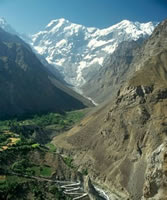HYDERABAD
 Once the capital of the Sind province, Hyderabad, today, is the second largest city in Sind. The city was founded in 1768 by Ghulam Shah Kalhora, the ruler of Sind. The city derived its name from Haidar Ali, the son-in-law of Prophet Mohammed(PBUH). After the Kalhoras, the city came under the reign of Talpur rulers, who were at the helm till 1843. Later, Hyderabad came under the British, who shifted the capital to Karachi.
Once the capital of the Sind province, Hyderabad, today, is the second largest city in Sind. The city was founded in 1768 by Ghulam Shah Kalhora, the ruler of Sind. The city derived its name from Haidar Ali, the son-in-law of Prophet Mohammed(PBUH). After the Kalhoras, the city came under the reign of Talpur rulers, who were at the helm till 1843. Later, Hyderabad came under the British, who shifted the capital to Karachi.If there is one thing that Hyderabad is quite popular for, is the Shahi Bazaar, which is the longest bazaar in Asia. The bazaar is a wonderful experience to get a feel of local life in Hyderabad. For a shopping enthusiast, Shahi Bazzar is an exciting experience as you get a different item at every corner of the bazzar. Interestingly, it is quite amazing, as you don't know what new thing you may come across at the next shop. It is just fun all the way at Shahi Bazaar. Some of the items that you can shop for include local handicrafts, glass tiles, ornamented silk items and lacquered wood items.
Kalhora Monuments in Hydrabad make popular tourist attractions. There are a number of monuments in Hyderabad that you can visit. Some of the monuments date back to the 18th century. Pacca Fort and Sindhology Museum are two tourist attractions that are a must visit in Hyderabad.
The city is located on the east of the Indus River and offers a wonderful boating experience on the river Indus. Tourists can travel to Hussainabad from Hyderabad and enjoy boat cruise on the Indus.
Hyderbad is well connected with Karachi and Peshawar by rail and road. The 160-km long high way links Hyderabad to Karachi and it takes about three hours to reach Hyderabad from Karachi.
Geography and climate:
Located at 25.367°N latitude and 68.367°E longitude with an elevation of 13 m (43 ft) AMSL, Hyderabad is located on the east bank of the Indus River and is roughly 150 km away from Karachi, the capital of the province. Hyderabad is the second largest city in Sindh, eighth largest in Pakistan and 209th largest city of the world with respect to population. Its population estimates to 1,348,288 (as of 2000). Two of Pakistan's largest highways, the Indus Highway and the National Highway join at Hyderabad. Several towns surrounding the city include Kotri at 6.7 km, Jamshoro at 8.1 km, Hattri at 5 km and Husri at 7.5 km.
Hyderabad has an extreme climate. The days are hot and dry usually going up to extreme highs of 40°C, whilst the nights are cool and breezy. Winds that blow usually bring along clouds of dust, and people prefer staying indoors in the daytime, while the breeze that flows at night is pleasant and clean.
In recent years Hyderabad has seen spills of heavy downpour. In 2003, Hyderabad received 105 millimetres of rain in 12 hours contributing towards a sudden climate change welcomed only as Global Warming. Years 2006 and 2007 saw close contenders to this record rain with death toll estimated in hundreds all together.
People and culture:
Hyderabad is noteworthy in Sindh and Pakistan generally for its relative tolerance towards religious and ethnic affairs. During the partition 1947 a large number of Muslim refugees migrated to Hyderabad. Nowadays, native Sindhis and non-Sindhi speaking Sindhis live in harmony after a brief history of conflict. A large influx of Pakhtuns and Punjabis were attracted to Hyderabad after the Indus treaty settlement. Most Punjabis mixed with the local population however most Pakhtuns are distinct and separately living near the railway station and its vicinity.
Education:
The pre independence days were horrible educationwise for Muslims of Hyderabad. As there was only one school where Muslim students could study was Noor Mohammad High School. Which was founded by famous Sindhi eductionist Noor Mohammad. All other schools admitted only Hindu students.
The city being a gateway between the rural Sindh and the Greater Sindh, attracts students from the lesser developed regions of Sindh. Hyderabad has a huge number of schools, colleges and Universities.
A nerve center of Sindh nationalist and literary movements, the city now have better education facilities and new universities, colleges and school established. At one time a hub of economic, educational and cultural activities, a breeding ground of academicians, philanthropists, writers, lawyers, politicians, journalists, actors and actresses, Hyderabad also had its industrialists, trade unionists, political activists, bureaucrats, bankers and diplomats who made a significant contribution to sub-continental society. But this gracious city now seems to be slowly dying, although it still produces over a couple of dozen major and minor newspapers in both Sindhi and Urdu.
While Christians constitute 2% of the total population, Hyderabad is the seat of a Diocese of the Church of Pakistan and has five churches and a cathedral.
Despite its strategic location and thrifty people the city is under the shadow of Karachi and yet to make its mark economically. One reason for this is the artificial factional and sectarian isolation imposed after the riots of late 1980s and early 1990s which cleft the urban population.
The city also has a sizeable diaspora.



Comments
Post a Comment